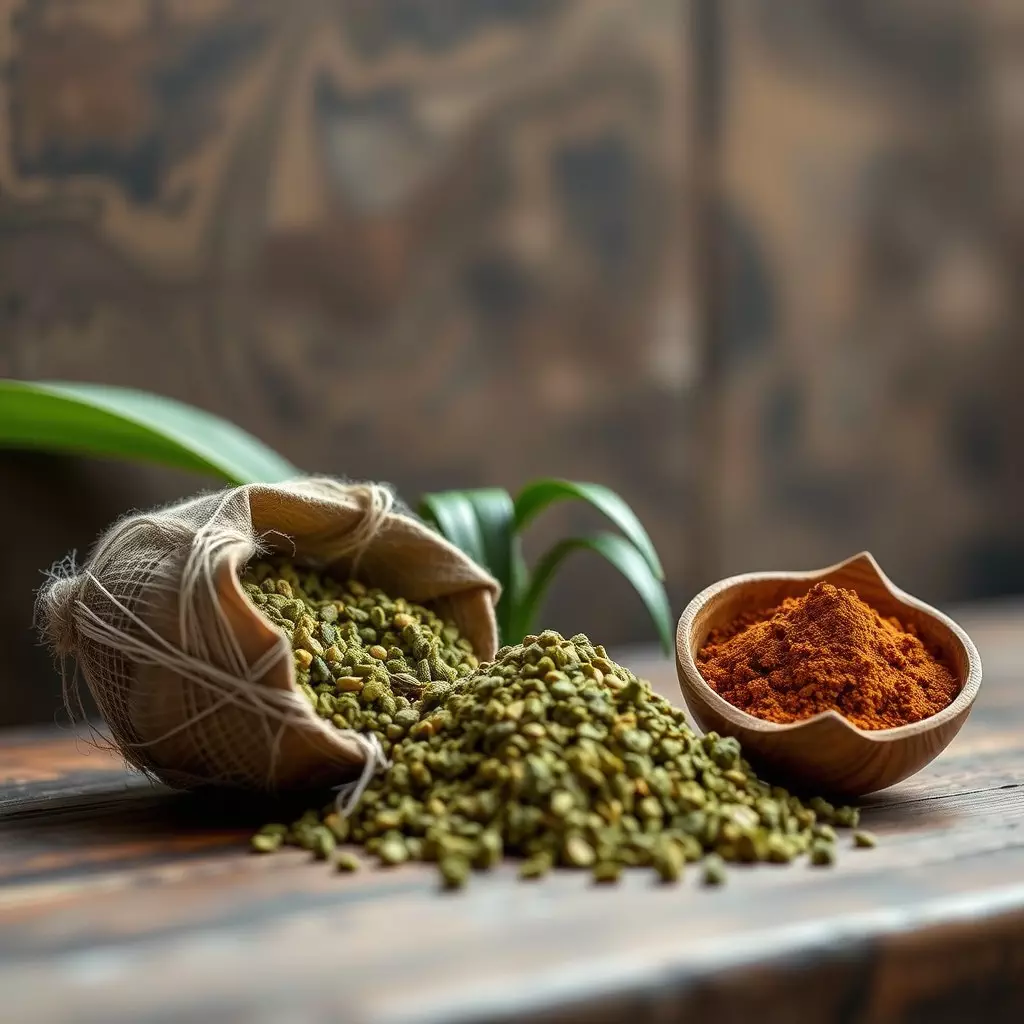Green Maeng Da and Red Bali are two strains of kratom, a natural substance used for pain relief with distinct effects. Green Maeng Da is recognized for its analgesic properties that provide pain relief without heavy sedation, ideal for maintaining alertness during the day. It's particularly beneficial for chronic pain management due to its balanced alkaloid profile that offers stimulating effects at lower doses and enhanced analgesia at moderate doses. In contrast, Red Bali is known for its strong sedative benefits, which can be advantageous for those experiencing severe or nighttime pain, potentially improving sleep quality. The choice between the two should be made based on individual pain needs and preferences, with caution due to their different effects. Users are advised to consult healthcare providers before using kratom, given its potential interactions with other medications and side effects, as well as to be aware of the varying legal statuses of kratom across regions. This comparison of Green Maeng Da vs Red Bali underscores the importance of understanding each strain's unique benefits within the broader context of natural alternatives for chronic pain management.
Chronic pain pervasively affects millions, often leading to a quest for effective management strategies. Among the alternatives, kratom emerges as a subject of interest due to its potential analgesic properties. This article delves into the multifaceted relationship between chronic pain and kratom, providing readers with a comprehensive understanding of the substance’s role. We explore the distinct effects of Green Maeng Da versus Red Bali kratom strains in managing pain, offering a comparative analysis that can guide informed decisions. Furthermore, we navigate the nuanced aspects of dosage and effects to promote safe use for pain relief. Understanding the intricacies of green maeng da vs red bali within the context of chronic pain management is crucial for those seeking alternative solutions.
- Understanding Chronic Pain and the Role of Kratom: An Overview
- Green Maeng Da vs. Red Bali Kratom: A Comparative Analysis for Pain Management
- Navigating Dosage and Effects: Safe Use of Green Maeng Da and Red Bali for Pain Relief
Understanding Chronic Pain and the Role of Kratom: An Overview

Chronic pain, a persistent and often debilitating condition, affects millions worldwide. It encompasses any pain lasting longer than three to six months beyond the usual time of healing, and can significantly diminish quality of life. Various therapeutic approaches are employed to manage this complex issue, with individuals seeking effective relief from symptoms. Among the natural alternatives considered by some for chronic pain management is kratom, a tropical evergreen tree native to Southeast Asia. Kratom leaves contain alkaloids that have been traditionally used for their stimulant and sedative properties, as well as for pain relief.
Within the kratom realm, two particularly prominent strains are Green Maeng Da and Red Bali. These strains offer different effects due to their unique alkaloid profiles. Green Maeng Da is celebrated for its balanced and potent analgesic effects, which can help manage chronic pain without the sedative side effects often associated with opioids. On the other hand, Red Bali is recognized for its strong sedative qualities, which can complement pain relief by promoting relaxation and reducing muscle tension. Users often experiment with these strains to find the most effective kratom variety that aligns with their specific needs and pain types. It’s important for anyone considering kratom as a part of their chronic pain management plan to consult with a healthcare provider, as kratom can interact with other medications and may have side effects. Additionally, the legal status of kratom varies by region, and regulatory considerations should be taken into account. Understanding both the potential benefits and limitations of kratom is crucial for informed decision-making in the context of chronic pain management.
Green Maeng Da vs. Red Bali Kratom: A Comparative Analysis for Pain Management

Green Maeng Da and Red Bali Kratom are two popular strains often explored by individuals seeking natural pain management solutions. Green Maeng Da, derived from the leaves’ younger, more tender vein, is renowned for its invigorating yet soothing effects. It contains a balanced blend of alkaloids, including 7-hydroxymitragynine and mitragynine, which are thought to contribute to its pain-relieving properties. Users frequently report that Green Maeng Da helps manage chronic pain with a sense of energy preservation, making it suitable for daytime use for those requiring pain relief without sedation.
In contrast, Red Bali Kratom is sourced from the Indonesian island of Bali and is known for its potent analgesic effects. This strain’s leaves are typically larger and older, leading to a higher concentration of alkaloids, particularly mitragynine. Red Bali is celebrated for its sedative qualities alongside its pain-relieving capabilities. It is often preferred by individuals who experience chronic pain that disrupts sleep or by those who require relief from discomfort in the evening. The sedative effects can also aid in relaxation and improve sleep quality, which is crucial for overall well-being, especially for those with chronic pain conditions. Both strains have unique alkaloid profiles that influence their efficacy in pain management; however, the choice between Green Maeng Da and Red Bali may depend on the user’s specific needs and preferences at different times of the day. Users should always approach Kratom use responsibly and consider consulting with a healthcare professional before incorporating it into their pain management regimen.
Navigating Dosage and Effects: Safe Use of Green Maeng Da and Red Bali for Pain Relief

When considering natural approaches for chronic pain management, kratom has emerged as a topic of interest among individuals seeking alternative therapies. Two particularly popular strains of kratom for pain relief are Green Maeng Da and Red Bali. Both strains offer distinct benefits, and understanding the nuances between them is crucial for safe and effective use.
Green Maeng Da is known for its balanced alkaloid profile, which can provide both stimulating and sedating effects depending on the dosage. It’s often recommended for pain relief without the heavy sedation that some experience with Red Bali. The effects of Green Maeng Da can be subtle at lower doses, typically ranging from 1 to 3 grams, where it can alleviate chronic pain while maintaining cognitive clarity. As the dosage increases to the moderate range of 3 to 6 grams, its analgesic properties become more pronounced. Conversely, Red Bali is celebrated for its strong sedative qualities, which can be beneficial for individuals dealing with severe or persistent pain that disrupts sleep and rest. The recommended starting dose for Red Bali is around 4 to 6 grams, with effects intensifying at higher doses. However, due to its potency, it’s essential to approach Red Bali with caution, especially if one has a low tolerance for kratom. Both strains should be used responsibly and within the recommended dosage ranges to minimize potential side effects and ensure safety. It’s important to consult with a healthcare provider before integrating kratom into any pain management regimen, as individual responses can vary significantly. Additionally, users should be aware of their local laws and regulations regarding kratom use.
Considerable insight into the complexities of chronic pain management, particularly through the lens of kratom, has been provided in this discourse. The comparison between Green Maeng Da and Red Bali kratom strains sheds light on their unique roles in pain relief, highlighting the importance of individualized approaches to effective management. Navigating dosage and effects for safe use is critical for those exploring these alternatives. It’s clear that while kratom may offer promising avenues for pain alleviation, further research and regulation are necessary to ensure its responsible utilization. Users are encouraged to consult healthcare professionals before integrating kratom into their wellness routines, given the nuanced nature of chronic pain and the potential impact of kratom on overall health.






